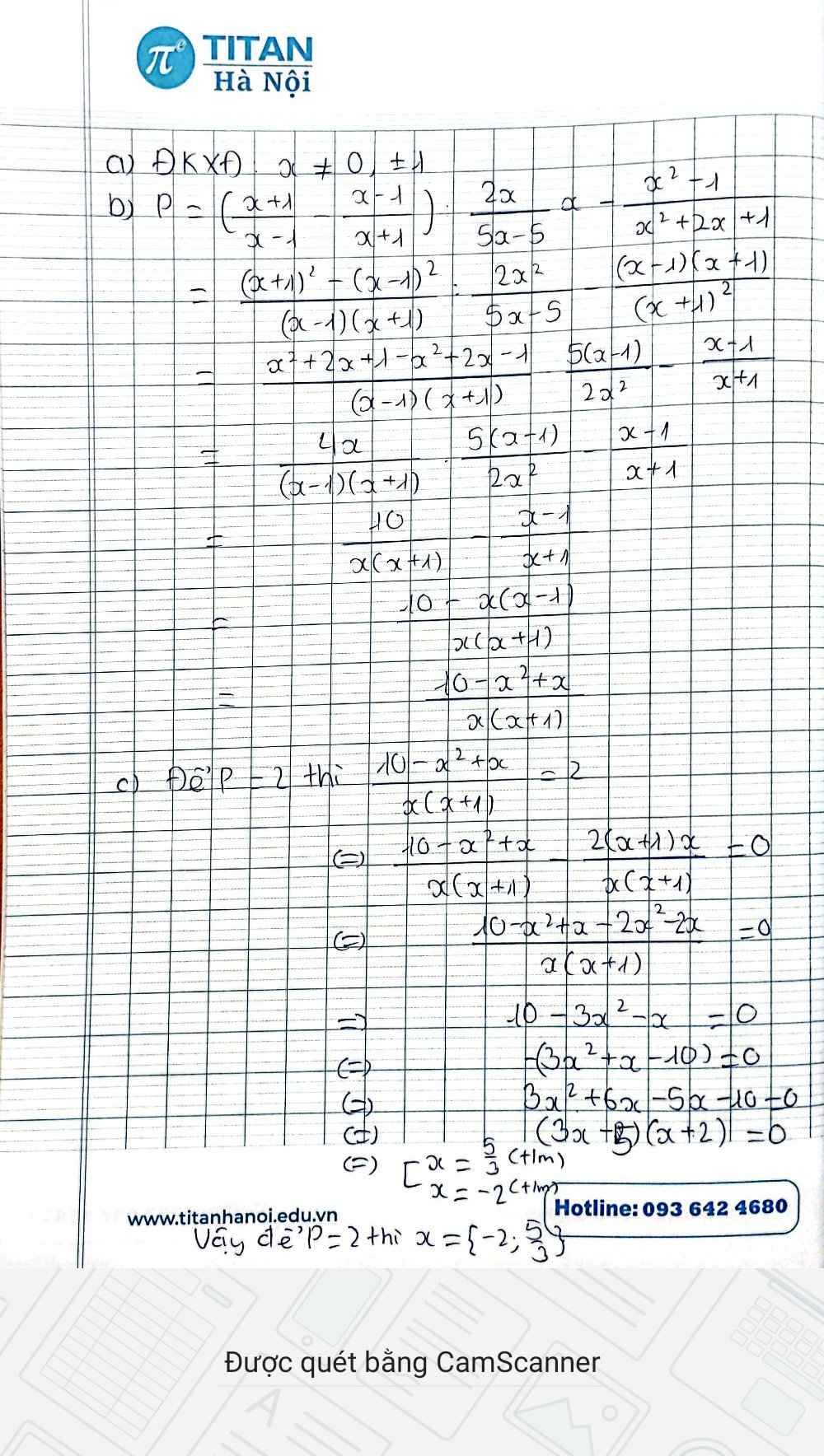Hãy nhập câu hỏi của bạn vào đây, nếu là tài khoản VIP, bạn sẽ được ưu tiên trả lời.

\(C=\left(\dfrac{2x^2+1}{x^3-1}-\dfrac{1}{x-1}\right)\div\left(1-\dfrac{x^2-2}{x^2+x+1}\right)\)
ĐKXĐ: \(x\ne1\)
\(C=[\left(\dfrac{2x^2+1}{(x-1)\left(x^2+x+1\right)}-\dfrac{1}{x-1}\right)]\div\left(1-\dfrac{x^2-2}{x^2+x+1}\right)\)
\(\Leftrightarrow C=[\left(\dfrac{2x^2+1}{(x-1)\left(x^2+x+1\right)}-\dfrac{1\left(x^2+x+1\right)}{(x-1)\left(x^2+x+1\right)}\right)]\div[\dfrac{(x-1)\left(x^2+x+1\right)}{(x-1)\left(x^2+x+1\right)}-\dfrac{(x^2-2)(x-1)}{(x^2+x+1)\left(x-1\right)}]\)
\(\Rightarrow C=\left[2x^2+1-1\left(x^2+x+1\right)\right]\div\left[\left(x-1\right)\left(x^2+x+1\right)-\left(x-1\right)\left(x^2-2\right)\right]\)
\(\Rightarrow C=(2x^2+1-x^2-x-1)\div\left[\left(x-1\right)\left(x^2+x+1-x^2+2\right)\right]\)
\(\Rightarrow C=\left(x^2-x\right)\div\left[\left(x-1\right)\left(x+3\right)\right]\)

a) đk: x khác 0;1
\(A=\dfrac{x\left(x+1\right)}{\left(x-1\right)^2}:\left(\dfrac{x+1}{x}+\dfrac{1}{x-1}+\dfrac{2-x^2}{x\left(x-1\right)}\right)\)
= \(\dfrac{x\left(x+1\right)}{\left(x-1\right)^2}:\left[\dfrac{\left(x+1\right)\left(x-1\right)+x+2-x^2}{x\left(x-1\right)}\right]\)
= \(\dfrac{x\left(x+1\right)}{\left(x-1\right)^2}:\dfrac{x^2-1+x+2-x^2}{x\left(x-1\right)}\)
= \(\dfrac{x\left(x+1\right)}{\left(x-1\right)^2}.\dfrac{x\left(x-1\right)}{x+1}=\dfrac{x^2}{x-1}\)
b) Để \(\left|2x-5\right|=3\)
<=> \(\left[{}\begin{matrix}2x-5=3< =>2x=8< =>x=4\left(c\right)\\2x-5=-3< =>2x=2< =>x=1\left(l\right)\end{matrix}\right.\)
Thay x = 4 vào A, ta có:
\(A=\dfrac{4^2}{4-1}=\dfrac{16}{3}\)
c) Để A = 4
<=> \(\dfrac{x^2}{x-1}=4\)
<=> \(\dfrac{x^2}{x-1}-4=0< =>\dfrac{x^2-4x+4}{x-1}=0\)
<=> \(\left(x-2\right)^2=0\)
<=> x = 2 (T/m)
d) Để A < 2
<=> \(\dfrac{x^2}{x-1}< 2< =>\dfrac{x^2}{x-1}-2< 0< =>\dfrac{x^2-2x+2}{x-1}< 0\)
<=> \(\dfrac{\left(x-1\right)^2+1}{x-1}< 0\)
Mà \(\left(x-1\right)^2+1>0\)
<=> x - 1 < 0 <=> x < 1
KHĐK: x < 1 ( x khác 0)
e) Để A thuộc Z
<=> \(\dfrac{x^2}{x-1}\in Z\)
<=> \(x^2⋮x-1\)
<=> \(x^2-x\left(x-1\right)-\left(x-1\right)⋮x-1\)
<=> \(1⋮x-1\)
Ta có bảng:
| x-1 | 1 | -1 |
| x | 2 | 0 |
| T/m | T/m |
KL: Để A thuộc Z <=> \(x\in\left\{2;0\right\}\)
f) Để A thuộc N <=> \(x\in\left\{2;0\right\}\)

c) Để P=3 thì \(\dfrac{x+1}{2x}=3\)
\(\Leftrightarrow x+1=6x\)
\(\Leftrightarrow x-6x=-1\)
\(\Leftrightarrow-5x=-1\)
hay \(x=\dfrac{1}{5}\)(thỏa ĐK)
Vậy: Để P=3 thì \(x=\dfrac{1}{5}\)
a) Ta có: \(A=\dfrac{1}{x^2+x}+\dfrac{1}{x+1}\)
\(=\dfrac{1}{x\left(x+1\right)}+\dfrac{x}{x\left(x+1\right)}\)
\(=\dfrac{x+1}{x\left(x+1\right)}=\dfrac{1}{x}\)